Description
See Pattern Release Announcement for more photos.
Only logged in customers who have purchased this product may leave a review.
Material
Primary Fabric Coating fabric such as gabardine, woolen, boiled wool and non-stretch fleece
Lining Broadcloth, viscose lining, acetate lining, cupro, Bemberg lining, silk habotai, satin
Interfacing A Lightweight woven or weft-insertion fusible interfacing
Interfacing B Lightweight knit tricot fusible interfacing
Sleeve Head Fabric Felt or woolen—you can also use primary fabric; this piece will not be visible in the final garment so color matching is not necessary
Other Materials
- Twelve (12) 1” (25 mm) buttons
- Two (2) 13/16” (21 mm) buttons for welt pockets
- A set of very thin shoulder pads for set-in sleeves
- 16″ (41 cm) of 3/8” or 1/2” (1 cm or 1.25 cm)-wide straight fusible stay tape (or cut your own using lightweight woven fusible interfacing on the straight grain)
- A set of very thin shoulder pads for set-in sleeves
- For the belt: One (1) buckle with a center bar and a prong, measuring 2” (50 mm) in internal width
- For the belt: Seven (7) metal eyelets, measuring 5/32” (4 mm) in internal width, with a corresponding installation tool and an awl
Optional Materials
- Fray Check or equivalent (fabric treatments designed to prevent fraying and unraveling of fabric edge)
- Two (2) 13/16” (21 mm) buttons for epaulettes
- One (1) 13/16” (21 mm) buttons for gun flap
- Two (2) buckles with a center bar and a prong, measuring 1 1/4” (32 mm) in internal width for sleeve bands
- Six (6) metal eyelets, measuring 5/32” (4 mm) in internal width, with a corresponding installation tool and an awl for sleeve bands
Fabric Requirements
Most natural fibers shrink in the wash; be sure to have enough fabric. The requirements below assume that the fabric is already pre-shrunk.
|
|
00 |
0 |
2 |
4 |
6 |
8 |
10 |
12 |
14 |
16 |
18 |
20 |
| Primary Fabric |
| 54″ Wide |
yard |
3 1/4 |
3 1/4 |
3 1/2 |
3 1/2 |
3 1/2 |
3 1/2 |
4 1/4 |
4 1/4 |
4 1/4 |
4 1/4 |
4 1/2 |
4 1/2 |
| 135 cm Wide |
cm |
290 |
290 |
320 |
320 |
320 |
320 |
380 |
380 |
380 |
380 |
410 |
410 |
| Lining |
| 54″ Wide |
yard |
1 7/8 |
1 7/8 |
2 1/8 |
2 1/8 |
2 1/8 |
2 1/8 |
2 1/2 |
2 1/2 |
2 1/2 |
2 1/2 |
2 5/8 |
2 5/8 |
| 135 cm Wide |
cm |
170 |
170 |
190 |
190 |
190 |
190 |
230 |
230 |
230 |
230 |
240 |
240 |
| Interfacing A |
| 32″ Wide |
yard |
1 5/8 |
1 5/8 |
1 5/8 |
1 5/8 |
1 5/8 |
1 5/8 |
1 3/4 |
1 3/4 |
1 3/4 |
1 5/8 |
1 7/8 |
1 7/8 |
| 82 cm Wide |
cm |
150 |
150 |
150 |
150 |
150 |
150 |
160 |
160 |
160 |
150 |
170 |
170 |
| Interfacing B |
| 20″ Wide |
yard |
1 for all sizes |
| 50 cm Wide |
cm |
100 for all sizes |
| Sleeve Head Fabric |
| 45″ Wide |
yard |
1/4 |
1/4 |
1/4 |
1/4 |
1/4 |
1/4 |
1/4 |
1/4 |
1/4 |
1/4 |
1/4 |
1/4 |
| 115 cm Wide |
cm |
20 |
20 |
20 |
20 |
20 |
20 |
20 |
20 |
20 |
20 |
20 |
20 |
|
|
22 |
24 |
26 |
28 |
30 |
32 |
34 |
36 |
38 |
40 |
| Primary Fabric |
| 54″ Wide |
yard |
4 1/2 |
4 1/2 |
4 5/8 |
4 5/8 |
4 5/8 |
4 5/8 |
4 7/8 |
4 7/8 |
4 7/8 |
4 7/8 |
| 135 cm Wide |
cm |
410 |
410 |
420 |
420 |
420 |
420 |
450 |
450 |
450 |
450 |
| Lining |
| 54″ Wide |
yard |
2 5/8 |
2 5/8 |
3 1/8 |
3 1/8 |
3 1/8 |
3 1/8 |
3 1/4 |
3 1/4 |
3 1/4 |
3 1/4 |
| 135 cm Wide |
cm |
240 |
240 |
280 |
280 |
280 |
280 |
300 |
300 |
300 |
300 |
| Interfacing A |
| 32″ Wide |
yard |
1 7/8 |
1 7/8 |
2 1/8 |
2 1/8 |
2 1/8 |
2 1/8 |
2 1/4 |
2 1/4 |
2 1/4 |
2 1/4 |
| 82 cm Wide |
cm |
170 |
170 |
190 |
190 |
190 |
190 |
200 |
200 |
200 |
200 |
| Interfacing B |
| 20″ Wide |
yard |
1 for all sizes |
| 50 cm Wide |
cm |
100 for all sizes |
| Sleeve Head Fabric |
| 45″ Wide |
yard |
1/4 |
1/4 |
1/4 |
1/4 |
1/4 |
1/4 |
1/4 |
1/4 |
1/4 |
1/4 |
| 115 cm Wide |
cm |
20 |
20 |
20 |
20 |
20 |
20 |
30 |
30 |
30 |
30 |



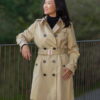

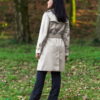
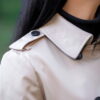
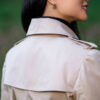


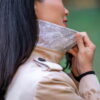

Crystal –
This sewing pattern was drafted professionally! I love how my trench coat turned out. It’s exactly how I want it to be… those pattern pieces are like puzzle pieces that fit perfectly to each other. I am so glad i have this sewing pattern. It’s a treasure!
Anne –
Have enjoyed sewing this pattern the instructions hold your hand throughout never thought I would be able to sew a trench coat but I love it, I think I may be making another. Thank you Kenis.